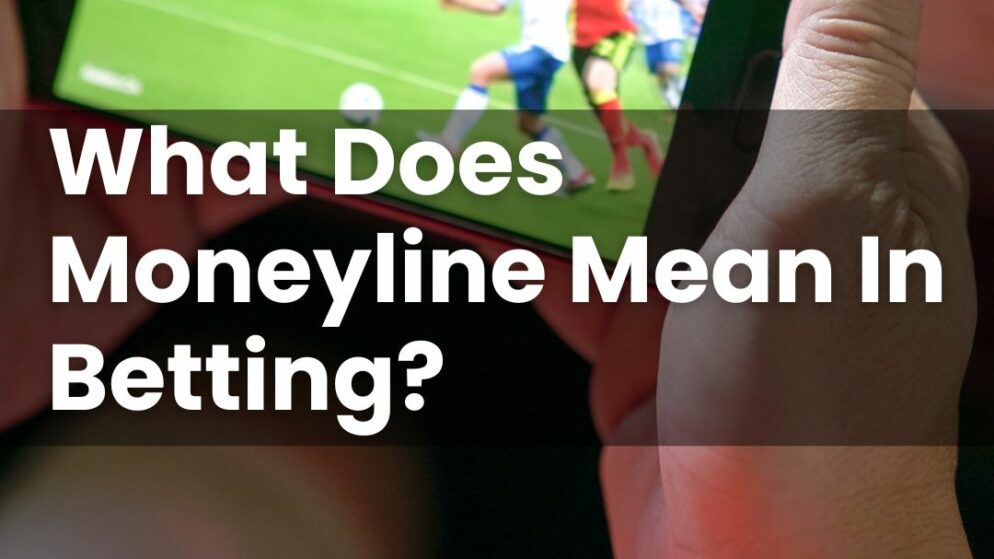

Betting can be a fun activity, but it often involves a variety of terms and phrases that may be unfamiliar, especially for newcomers. One such term that commonly appears in sports betting is “moneyline.”
In this blog post, we aim to break down the basics of moneyline betting and offer an example to help readers understand how it can be used in real-world situations. For those just starting out in sports betting, grasping the concept of moneylines can be a helpful first step.
It’s important to approach any form of betting with caution, ensuring that you always bet responsibly and within your means.
What Is Moneyline In Betting?
A moneyline bet involves trying to predict the outcome of a match or event by choosing the team, player, or competitor you believe is most likely to win. In a moneyline bet, each option is given odds- these odds indicate how much you could potentially win based on your stake.

For instance, in a football match, you will see odds listed next to each team. You place your bet on the team you think will win, and if that team wins, your bet wins as well. The straightforward nature of trying to predict the winner makes moneyline betting a popular choice for beginners.
Whilst the odds can indicate who is most likely to win, it’s important to keep in mind that ultimately gambling is based on chance. There are many extenuating factors, such as the weather, that can affect the outcome of a sports event, and no strategy can ever guarantee success.
How Do Moneyline Bets Work?
The odds in a moneyline bet can help you understand the potential return on your bet if your selection is successful. These odds typically reflect the likelihood of each competitor winning, with most events having a favourite and an underdog.
The favourite usually has lower odds, indicating a higher chance of winning. If you bet on the favourite and they win, your potential returns might be smaller. Conversely, the underdog tends to have higher odds, suggesting a lower chance of winning. If you choose to bet on the underdog and they win, your potential return could be higher.
It’s important to understand how odds are presented, as they can vary between events and bookmakers. Always approach betting with caution and ensure that you only wager what you can afford to lose.
How Are Moneyline Odds Calculated?
Moneyline odds are mainly used in the United States to show how much you could potentially win, or need to stake. In the UK, odds are usually shown in fractional or decimal format, but understanding moneyline odds can still be useful, especially for American sports.
Fractional odds, like 5/2, mean you could win £5 profit for every £2 staked, if successful. To convert fractional odds into the moneyline format, follow these steps:
- Divide the first number by the second to get a decimal.
For 5/2: 5 ÷ 2 = 2.5 - If the result is over 1 (an underdog), multiply by 100:
2.5 × 100 = +250 - If the result is under 1 (a favourite), divide 100 by the decimal and add a minus sign:
For 1/3: 1 ÷ 3 = 0.33 → 100 ÷ 0.33 = -303
So, +250 means a £100 stake could return £250 profit if successful, while -303 means you’d need to stake £303 to potentially win £100.
You can also use online converters to avoid manual calculations. These can show the moneyline equivalent, decimal odds, and implied probability. Keep in mind that all betting involves chance. Odds reflect probability but don’t predict or guarantee results.
How To Read Moneyline Odds
Moneyline odds are used by sportsbooks to indicate the likelihood of a competitor winning. These odds can appear in different formats, including American, decimal, or fractional.
In the American format, moneyline odds are presented as either positive or negative numbers. Negative odds generally indicate the favourite, or the competitor most likely to win, while positive odds are used for the underdog, indicating a lower chance of success.
Although decimal and fractional odds are less commonly used for moneyline betting, they can still help in understanding how potential returns are calculated.
What Does -150 Moneyline Mean?
A moneyline of -150 is expressed in the American format. The negative sign indicates that the competitor is the favourite to win. In this case, bettors would need to stake £150 in order to potentially win £100. If your selection is successful, your total return would be £250, which includes your original stake of £150 plus the £100 in profit.
Moneyline Bet Example
To help illustrate how moneyline betting works, let’s consider an example using a football match between Team A and Team B.
The bookmaker might present the moneyline odds as follows:
- Team A: -150
- Team B: +180
In this case, Team A is the favourite, as indicated by the negative moneyline. This means bettors would need to bet £150 to potentially win £100 in profit, in addition to getting their original stake back if Team A wins.
On the other hand, Team B is the underdog, with the positive moneyline of +180. If bettors bet £100 on Team B and they win, their potential return would be £180 in profit, plus their original stake.
Are Moneyline Bets Worth It?
Whether moneyline bets are worthwhile largely depends on individual preferences and perspective.
As with all forms of betting, there are no guarantees of success. Every bet, including moneyline wagers, carries an element of chance, meaning the outcome can be uncertain, regardless of how strong the favourite may seem.
Your personal approach to betting plays an important role in deciding if moneyline bets are suitable for you. Some bettors appreciate the straightforward nature of moneyline betting, enjoying the simplicity of attempting to predict a winner without needing to navigate more complex betting options.
By setting clear boundaries and considering your budget, you can potentially help to foster a more enjoyable and responsible experience when engaging with moneyline bets, or any other type of betting.









